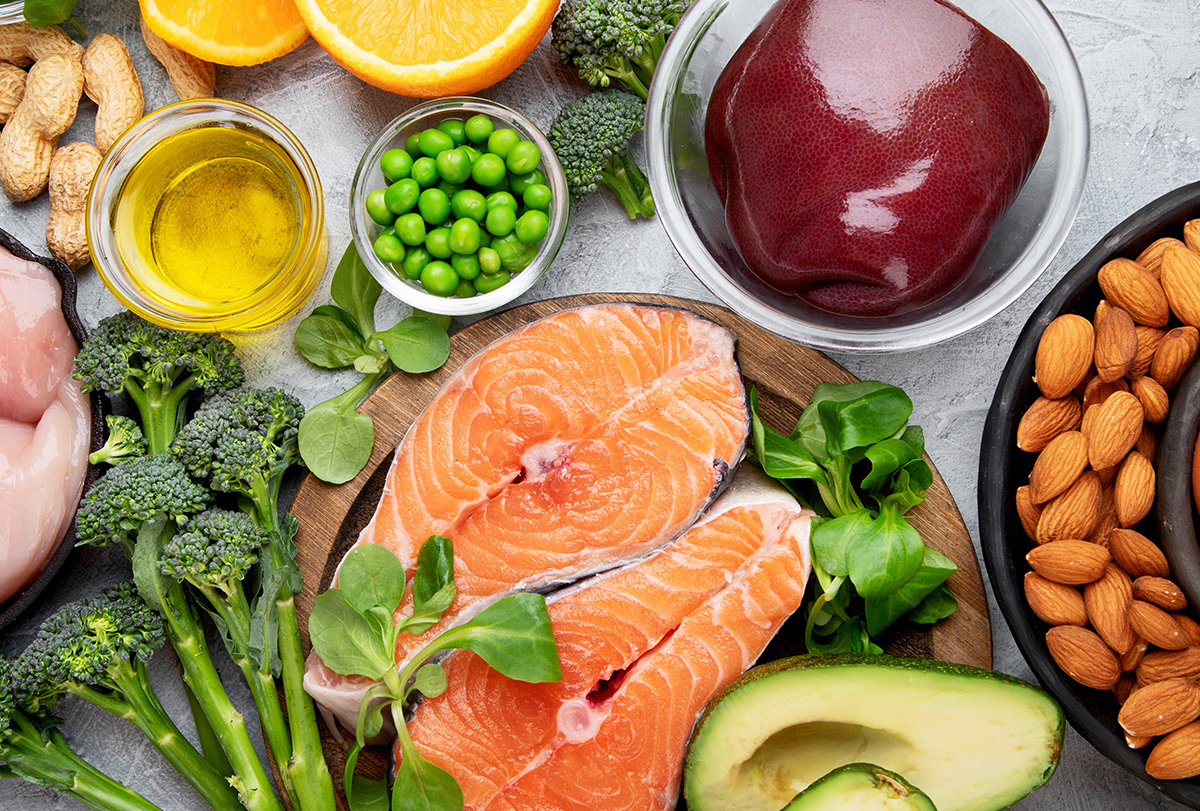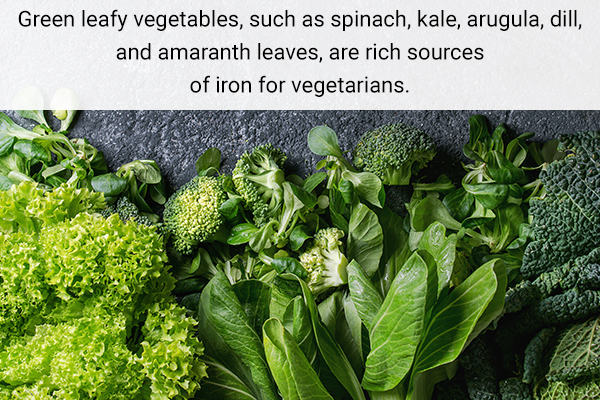In this article:
Anemia – characterized by low hemoglobin levels – is a common problem in many young women and children and during pregnancy all over the world. (1)

People with anemia are often lethargic, weak, and too tired to perform any tasks. They may experience shortness of breath while performing tasks and physical activity, and they may have low exercise tolerance. (1)
The normal hemoglobin levels are:
- 13.5 – 18 g/dL for men
- 12 – 15 g/dL for women
- 11 – 16 g/dL for children
During pregnancy, the ideal hemoglobin level should be over 10 g/dL. (1)
Anemia can be caused by nutrient deficiencies (low iron and folate in the diet), excessive bleeding (such as after surgeries or during menstruation), and illnesses that may cause depletion of iron and folic acid in the body. (1)
Most forms of anemia can be resolved by incorporating iron- and folate-rich foods into the diet. This article enumerates some of these foods and how they can help.
Are Iron-Rich Foods Effective?
Before you grab the iron-rich foods that help in combating anemia, it is important that you understand the role of iron in the diet.
The iron present in foods is of two major types: heme and nonheme.
Heme iron is found in nonvegetarian sources such as meat, fish, poultry, and eggs. It is absorbed much better by the human body without the need for additional nutrients that enhance iron absorption.
Nonheme iron is found in vegetarian sources such as legumes, beans, and seeds. It is the major source of iron for vegetarians, but it is absorbed in much lesser quantities (about 17% as compared to heme sources). They also need additional nutrients to enhance their absorption. (2)
Top Foods That Beat Anemia
Consume these vegetarian and nonvegetarian foods to increase your iron intake and improve your hemoglobin levels.
1. Meat

Animal meat from beef, lamb, poultry, and fish is a rich source of protein, iron, zinc, vitamin B12, and omega-3 fatty acids. Including animal meat in the diet is therefore the easiest and most effective way to increase your iron levels. (3)
Results of studies conducted in multiple countries showed that consumption of lean meats (up to 100 g each day) was significantly associated with reducing iron-deficiency anemia. (3)
It is recommended not to overcook the meat as prolonged heat results in reduced iron absorption. (4)
2. Liver

Organ meats from lamb, beef, and poultry are also packed with protein, iron, and omega-3 fatty acids. Absorption of iron from liver has been reported to be 25%–30%, which is significant when it comes to dealing with iron-deficiency anemia. (5)
Organ meats might be less palatable than the flesh of animals for some; however; consuming them at least once a week can be beneficial.
3. Eggs

Eggs are nutrient-dense foods and a great nutritional source for people of all age groups, especially children. One egg (chicken) can provide 13% of the daily requirement of iron.
The yolk has the most amount of iron, though its availability is lower due to the iron being tightly bound. Still, some studies have shown supplementation with eggs (one each day) can improve iron-deficiency anemia in children. (6)
4. Seafood

Fish is another great source of heme iron. Shellfish such as prawns and shrimps are also good sources of iron. A study done in Bangladesh identified that fish, shrimps, and prawns add 40% of heme iron to the diet. (7)
A high intake of animal protein from fish was also found to correlate to a lower chance of anemia in Japanese adults. (8)
5. Green leafy vegetables

Green leafy vegetables, such as spinach, kale, arugula, dill, and amaranth leaves, are rich sources of iron for vegetarians. In low socioeconomic communities, they can help fight micronutrient deficiencies. (9)
In regions of Africa, consumption of dark green leafy vegetables was associated with a better level of vitamin A and a lower risk of anemia. (9)
Green leafy vegetables can be stir-fried, steamed, or blanched for a side dish, used in soups and broths, or added to salads.
6. Beans

Beans are abundant in protein and iron and are great food sources for vegetarians. About 100 g of cooked beans contains 7–10 mg of iron, which is the daily iron requirement. (10)
However, beans also contain phytates that prevent iron from being readily absorbed by the body. Soaking beans before cooking them using a pressure cooker without throwing away the water in which they were soaked was found to be the best method to improve the absorption of dietary iron from beans. (10)
Iron-fortified beans are also available that can help improve the iron status of people with anemia. (11)
7. Pumpkin seeds

Pumpkin seeds are replete with trace minerals including iron. About 30 g of pumpkin seeds each day can give 4 mg of iron, which is approximately half of the daily recommended amount. (12)
One study showed that consumption of 30 g of pumpkin seeds as a snack improved the iron status of women.
Pumpkin seeds can be roasted and consumed as a snack by themselves or added to oatmeal, smoothies, and salads. (12)
8. Blackstrap molasses

Blackstrap molasses is obtained during the production of sugar by boiling sugar cane juice and cooking it down until a dark thick sludge remains. Several folk medicines including Ayurveda prescribe the use of blackstrap molasses for treating iron-deficiency anemia. (13)
Each 100 g of blackstrap molasses contains 5 mg of iron, which, along with the presence of absorption enhancers such as fructose, sulfur, and copper, makes blackstrap an effective supplement against anemia. (14)(15)
Blackstrap molasses can be used to sweeten drinks, topped on parfaits and oatmeal, and added to smoothies and desserts.
9. Watercress

Watercress grows in mainly aquatic areas and is chockful of many vitamins such as vitamins A, B, C, E, and K and folic acid, as well as minerals such as iron, calcium, magnesium, potassium, zinc, and phosphorus. (16)
About 100 g of watercress provides 4 mg of iron and 145 mg of vitamin C, making it a rich source of iron that is also easily absorbed. (14)
Watercress can be cooked like broccoli or cabbage (since it is a cruciferous vegetable), and consumed as a side dish or added to salads and soups.
10. Garden cress seeds

Garden cress is an herb packed with iron and often used for treating anemia, especially in pregnant and postpartum women.
In many cultures, garden cress seeds are used to enhance milk production after birth and treat infertility in men. (17)
Each 100 g of garden cress seeds contains 63 mg of iron, making it an extremely rich source of the mineral and a useful supplement in managing anemia. (17) Garden cress seeds can be roasted and added to salads and smoothies. It can also be mixed with other nuts and made into granola bars.
How to Enhance Iron Availability
To manage anemia, several things can be done to enhance the absorption of iron from the food you eat. Here are a few:
- Take vitamin C along with your iron-rich food. (2)
- Cook nonheme sources of iron (such as beans and green leafy vegetables) along with heme sources such as fish, meat, and poultry. The protein in meat can increase nonheme iron absorption 2–3 times more. (2)
- Use iron vessels such as pans, woks, and ingots to prepare food. This not only increases the amount of iron in the food but also improves its availability. (18)
Most-Asked Questions
Can I eat jaggery if I am anemic?

Yes. Jaggery is obtained from sugarcane by boiling sugarcane juice in large iron vats, which makes the jaggery iron rich.
In some regions, jaggery is used for many health conditions. It is teeming with antioxidants, polyphenols, vitamins, and minerals such as calcium, phosphorus, and iron.
Jaggery is used for iron-deficiency anemia as it may help increase hemoglobin levels. Choose darker jaggery as it is likely to be richer in iron.
How long does it take for hemoglobin levels to become normal?
With the daily inclusion of iron in the diet, it may take 2–4 weeks for hemoglobin levels to rise. (19)
Final Word
Iron deficiency anemia is a common problem in young women, children, and pregnant women. It can interfere with daily life by causing lethargy, tiredness, and fatigue.
Oftentimes, iron deficiency is caused by a lack of iron and decreased bioavailability of iron in the food you eat. Therefore, it is important to include not only iron-rich foods such as those mentioned in this article but also iron absorption enhancers such as vitamin C in the diet.
- Was this article helpful?
- YES, THANKS!NOT REALLY


